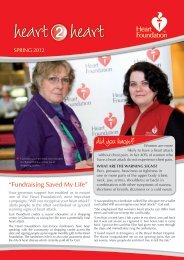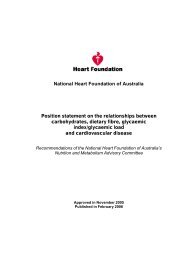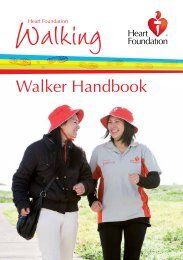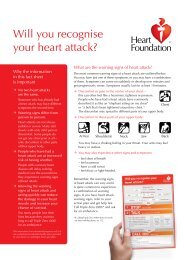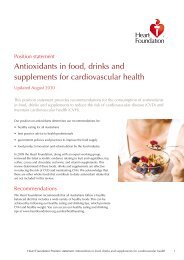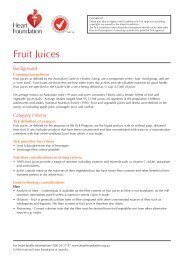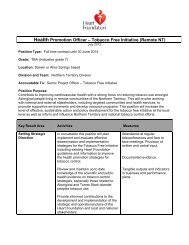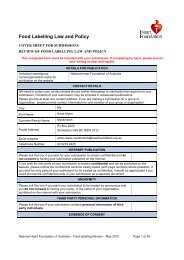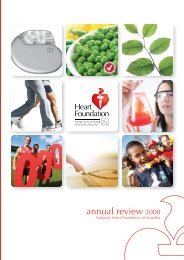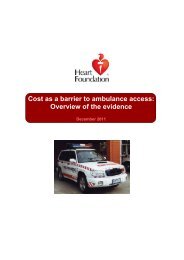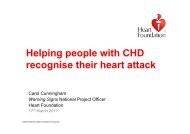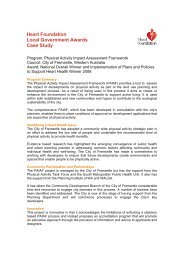Healthy by Design - National Heart Foundation
Healthy by Design - National Heart Foundation
Healthy by Design - National Heart Foundation
Create successful ePaper yourself
Turn your PDF publications into a flip-book with our unique Google optimized e-Paper software.
13 14<br />
Local destinations<br />
<strong>Design</strong> objective<br />
To provide local destinations to support lively, walkable and<br />
rideable neighbourhoods.<br />
<strong>Design</strong> considerations<br />
Support mixed use, walkable neighbourhoods<br />
• Locate food stores, shops and local facilities (such as post<br />
boxes and public telephones) within close walking distance to<br />
dwellings and businesses. The concept of ‘close walking<br />
distance’ will vary according to people’s different fitness levels<br />
but usually ranges between 400 to 800 metres.<br />
• Create neighbourhood clusters through the use of corner stores<br />
and cafés. This encourages people to socialise and contributes<br />
to the local economy and community life. To make these<br />
facilities viable for business owners and convenient for local<br />
residents, co-locate with, or within 200 metres of, community<br />
centres, schools, parks and public transport.<br />
A widely used benchmark is for mixed<br />
development neighbourhoods to cover a<br />
400-metre radius. This equates to about a<br />
five-minute walk. (English Partnerships 2000)<br />
Provide a community ‘heart’<br />
• <strong>Design</strong> buildings to facilitate a variety of uses within a<br />
neighbourhood, providing opportunities for activity at different<br />
periods of the day and night. For example, schools may be used<br />
after hours as community facilities and public libraries for<br />
educational and training sessions.<br />
• Locate community buildings so they can contribute to a sense<br />
of place and provide a community ‘heart’.<br />
Support pedestrian access to local destinations<br />
• Provide safe pedestrian access to local destinations<br />
(refer ‘Streets’).<br />
• Clearly mark pedestrian access through car parks.<br />
Provide amenities for comfort and convenience<br />
• Provide suitable shade shelters in public destinations such as<br />
open squares and over play equipment, BBQs and picnic seats.<br />
• Provide drinking fountains at local destinations.<br />
• Provide secure bicycle parking facilities at trip end cycling<br />
destinations such as local train stations, supermarkets, parks or<br />
sporting ovals.<br />
For further information on the provision of bicycle parking facilities, see also:<br />
Austroads ‘Guide to Traffic Engineering Practice – Part 14, Bicycles’.<br />
Australian Standard AS2890.3, Bicycle Parking Facilities.<br />
Brochure: ‘Bicycle Parking: providing bicycle parking facilities’ (jointly produced <strong>by</strong><br />
Bicycle Victoria, Retail Cycle Traders Australia, Victoria Police, the RACV and<br />
VicRoads). February 2000.<br />
Bicycle Parking Solutions booklet (produced <strong>by</strong> Bicycle Victoria) 2004.<br />
• Assess the need for public toilet provision at local destinations.<br />
The City of Melbourne has produced ‘Toilet Management: Strategy and <strong>Design</strong><br />
Guidelines for the City of Melbourne’. The guidelines present information on<br />
location, design and management of public toilets. A checklist is provided with<br />
elements to consider in toilet management and design. Visit<br />
www.melbourne.vic.gov.au.



